Have you ever wondered what creates the unique cultural identity of Northern Vietnam? The answer may lie deep within the traditional craft villages, where artistic essence has been passed down through generations. More than just places producing exquisite handicrafts, each craft village is a living museum, preserving the cultural, historical, and spiritual values of the Vietnamese people. Join “Du lịch khắp thế gian” (Travel Around The World) on a journey to explore the traditional craft villages of Northern Vietnam, to better appreciate the beauty and value of Vietnamese cultural heritage.
Bát Tràng Pottery Village: Where Earth is “Souled”
When mentioning traditional craft villages in Northern Vietnam, Bát Tràng, the cradle of Vietnamese ceramics, cannot be overlooked. Nestled peacefully along the Red River, in Gia Lâm district, Hanoi, Bát Tràng pottery village has existed and developed for over 700 years, becoming a familiar destination for those who love culture and want to learn about pottery.
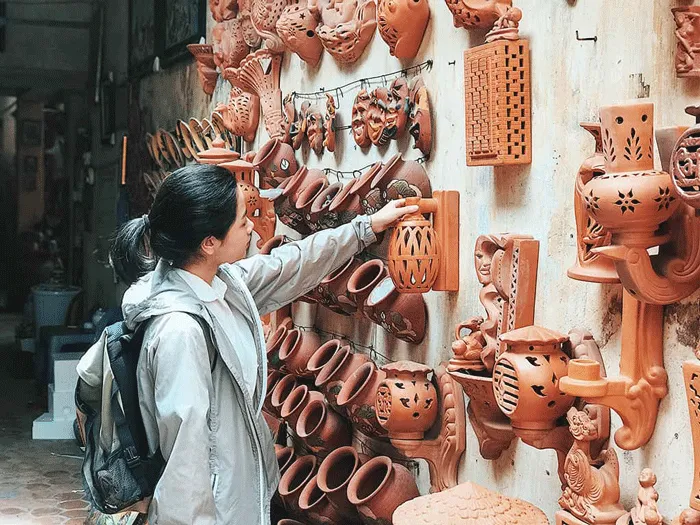
In Bát Tràng, you will not only admire sophisticated and diverse ceramic products in designs and types, but also have the opportunity to experience the unique handmade pottery process. Pottery-making families here are very enthusiastic in guiding visitors through the stages of kneading clay, shaping products on a turntable, drawing patterns, and glazing. Creating a small, lovely ceramic product with your own hands will be an unforgettable memory in your journey to explore Bát Tràng village.
After indulging in creativity with clay, don’t forget to visit Bát Tràng pottery market. This market offers countless ceramic products, from everyday household items such as bowls, plates, teapots, flower vases, to high-class fine art decorations, worship items, and miniature landscapes. Whether you want to shop for souvenirs or simply stroll and admire works of art made from baked earth, Bát Tràng pottery market is sure to bring interesting experiences.
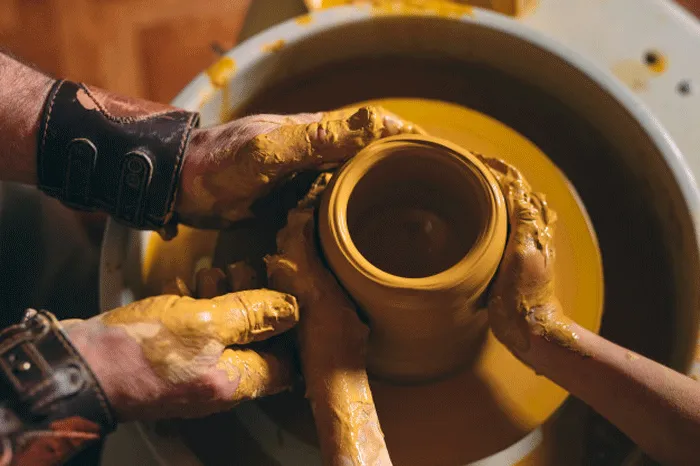
Travel tips for Bát Tràng pottery village:
- Ideal time: You can visit Bát Tràng at any time of the year. However, the cool autumn or spring weather will be most suitable for sightseeing and experiences.
- Transportation: From the center of Hanoi, you can easily get to Bát Tràng by bus (routes 47, 98), motorbike, or private car.
- Cost: The cost of visiting and experiencing Bát Tràng is quite reasonable. You can prepare about VND 200,000 – 500,000 for a day trip, including travel, food, and shopping expenses.
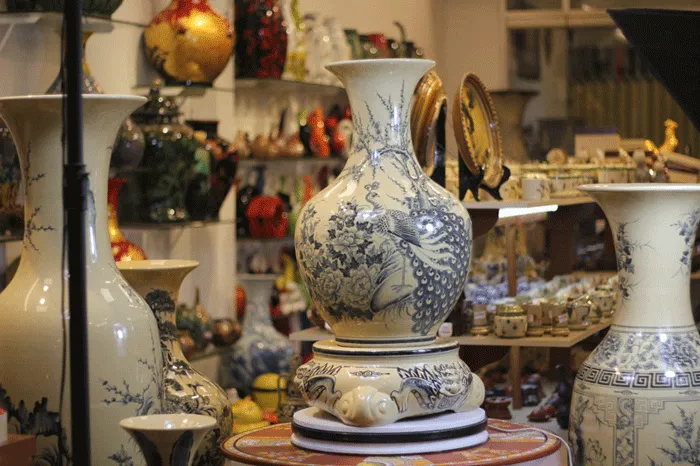
Đông Hồ Folk Painting Village: The Unique Beauty of Traditional Culture
Leaving Bát Tràng, let’s go to Đông Hồ painting village, Bắc Ninh, one of the cradles of Vietnamese folk painting. Đông Hồ village belongs to Song Hồ commune, Thuận Thành district, about 35km from Hanoi. This place is famous for woodcut paintings imbued with national cultural identity, especially during each Lunar New Year.
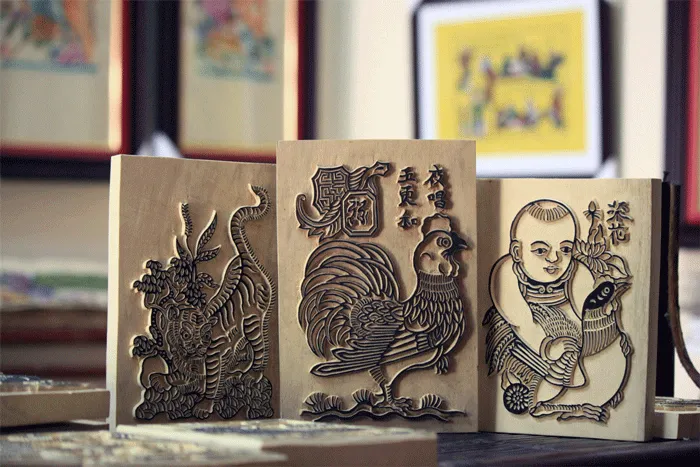
Coming to Đông Hồ village, you will admire paintings with bright colors, harmonious compositions, expressing aspirations for a prosperous and happy life, and the good customs and traditions of Vietnamese people. You can also learn about the process of creating a Đông Hồ painting, from the stage of carving woodblocks, mixing natural colors from plants, to the unique painting printing technique.
In addition to exploring the painting craft, you can combine a visit to Đông Hồ village with famous spiritual tourist attractions nearby such as Bút Tháp pagoda and Dâu pagoda. Dâu pagoda, located in the center of Bắc Ninh cultural tourism area, is one of the oldest pagodas in Vietnam, preserving many historical and Buddhist cultural values.
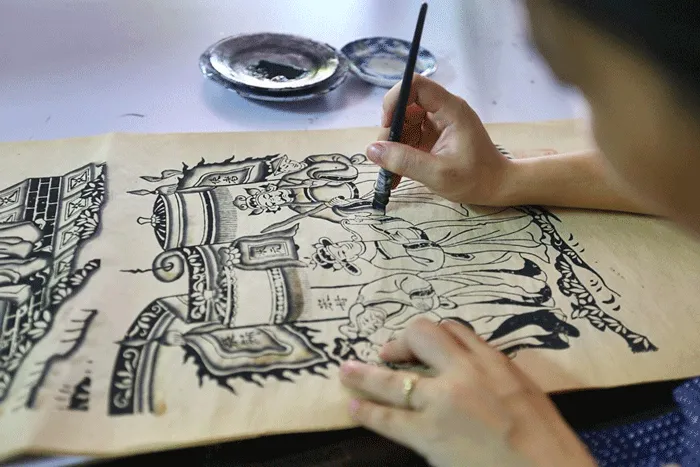
Travel tips for Đông Hồ painting village:
- Ideal time: The time near the Lunar New Year is when Đông Hồ painting village is busiest, you can clearly feel the atmosphere of traditional Tet painting making.
- Transportation: You can take a bus (route 203 from Hanoi to Bắc Ninh, then take a motorbike taxi or taxi to Đông Hồ village) or motorbike, private car in the direction of National Highway 1A or National Highway 5.
- Shopping: In addition to paintings, you can buy other products of Đông Hồ village such as bamboo notebooks, paper fans, and souvenirs imbued with folk culture.
Vạn Phúc Silk Village: “Jewel” of Hà Đông
Vạn Phúc silk village, also known as Hà Đông silk village, is located in Vạn Phúc ward, Hà Đông district, Hanoi, about 10km from the city center. With a history of over 1000 years, Vạn Phúc silk has become a famous brand, popular both domestically and internationally.

Vạn Phúc silk is famous for its softness, sheen, and delicate patterns. In feudal times, Vạn Phúc silk was used to tailor costumes for kings and court officials. Up to now, Vạn Phúc silk still maintains its position thanks to its superior quality and constant creativity in designs and styles.
When you come to Vạn Phúc silk village, you will witness firsthand the meticulous handmade silk weaving process, from selecting silk, dyeing colors, to weaving fabric and finishing products. You can also visit silk shops, admire and shop for diverse silk products such as silk fabrics, áo dài (traditional long dress), silk scarves, souvenirs…

Vạn Phúc silk is not only a fashion product, but also a work of art, containing the enthusiasm and talent of artisans. Each silk strip has its own beauty, from traditional patterns such as dragons, phoenixes, floating clouds, four seasons, to modern motifs, suitable for contemporary fashion trends.
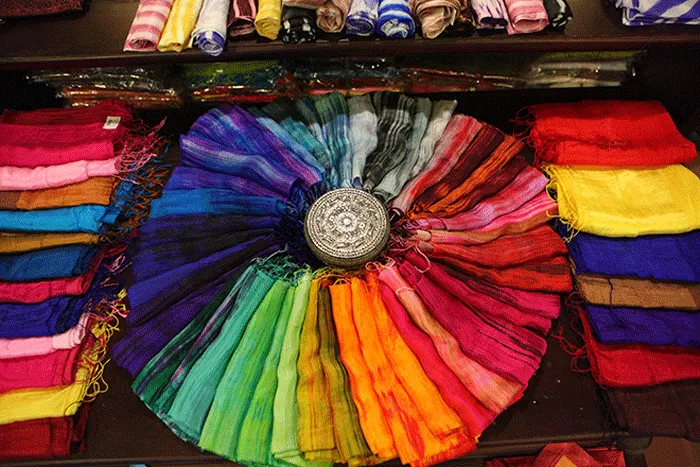
Travel tips for Vạn Phúc silk village:
- Transportation: You can easily get to Vạn Phúc silk village by bus (routes 02, 21A, 27, 37, 102), motorbike, or private car in the direction of Nguyễn Trãi – Lê Văn Lương – Tố Hữu streets.
- Shopping: You should refer to prices and product quality at many different stores to choose satisfactory items at the best prices.
- Experiences: In addition to shopping, you can experience trying on traditional silk áo dài, taking souvenir photos at the craft village, and learning about the history and culture of Vạn Phúc silk village.
Đọi Tam Drum Village: Echoes of Tradition
Đọi Tam drum village, belonging to Đọi Tam village, Đọi Sơn commune, Duy Tiên district, Hà Nam province, is a famous village with the traditional drum making craft that has existed for hundreds of years. The sound of Đọi Tam drums has resounded throughout the country, from famous festivals to important national events.
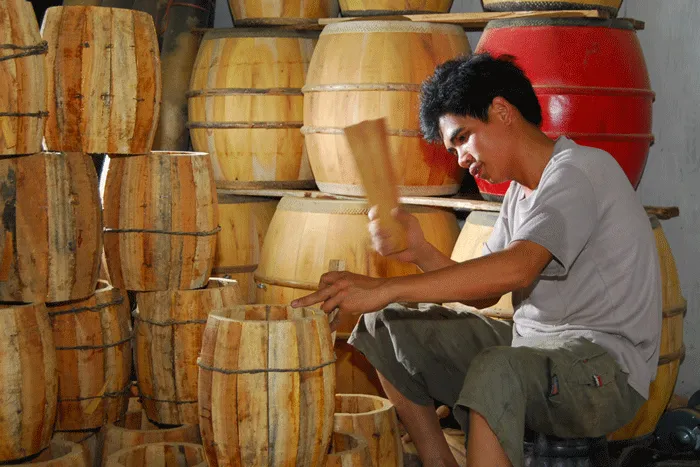
Coming to Đọi Tam drum village, you will discover the elaborate and meticulous drum making process, from selecting wood, drying, to assembling, stretching drumheads, and decorating. Drum making in Đọi Tam is highly family-oriented, techniques and experiences are passed down from generation to generation, mainly within families and to eldest sons.
One of the special highlights of Đọi Tam drum village is the thunder drum – the largest drum in Vietnam, made by the talented hands of village artisans. You will be amazed by the giant size and majestic beauty of this drum.

Travel tips for Đọi Tam drum village:
- Ideal time: You can visit Đọi Tam drum village during the festival season (usually in spring and autumn) to immerse yourself in the bustling atmosphere and admire unique drum performances.
- Transportation: From Hanoi, you can take a bus or motorbike in the direction of National Highway 1A to Hà Nam, then turn into a provincial road to get to Đọi Tam village.
- Experiences: In addition to visiting drum workshops, you can learn how to make basic drums, enjoy traditional drum performances, and buy small drums as souvenirs.
Sơn Đồng Craft Village: Exquisite Art of Wood Statue Carving
Sơn Đồng craft village, belonging to Sơn Đồng commune, Hoài Đức district, Hanoi, about 20km northwest of the city center, is famous for wood carving, statue carving, and making gilded and silver-plated lacquerware serving the spiritual life of the people.
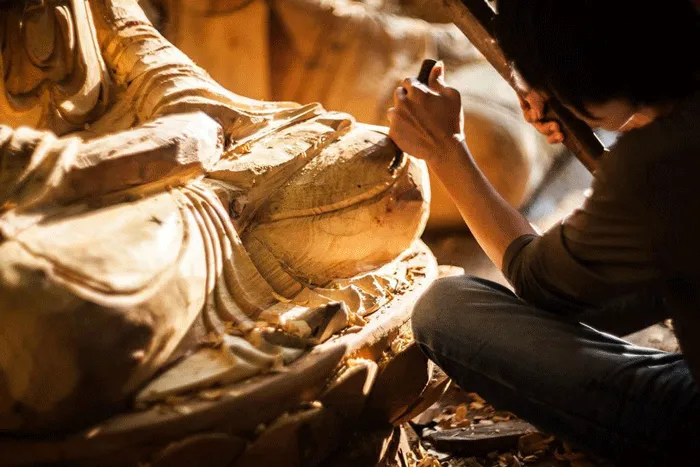
Stepping into Sơn Đồng village, you will feel like entering a living “museum” of wooden statues. Everywhere on the roads and alleys, you can see Buddha statues, Saint statues, statues of historical figures, worshiping mascots, horizontal lacquered boards, parallel sentences… being meticulously carved and gilded by artisans.
The process of making Sơn Đồng wooden statues requires the sophistication, meticulousness, and talent of artisans. From the stage of selecting wood, shaping, carving, to gilding, each stage is done by hand, with high concentration and deep passion for the profession.

Products of Sơn Đồng craft village are not only used in communal houses, temples, and shrines, but are also loved and collected by many people to decorate houses and worship spaces. Sơn Đồng wooden statues are not only decorative items, but also carry deep cultural and spiritual values.
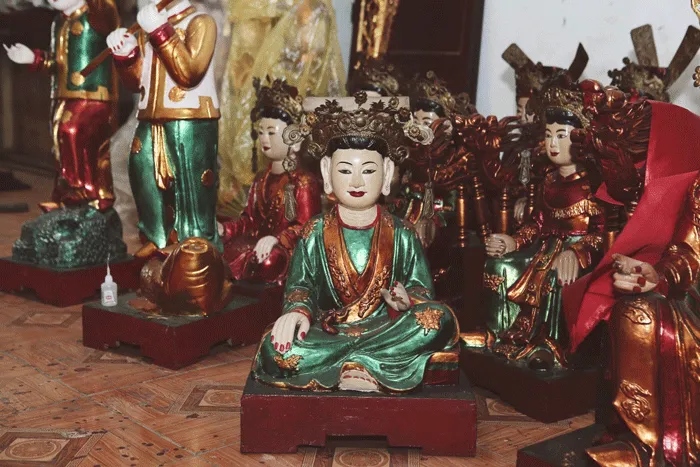
Travel tips for Sơn Đồng craft village:
- Ideal time: You can visit Sơn Đồng craft village at any time of the year. However, you should avoid hot sunny days in the summer.
- Transportation: You can take a bus (routes 73 or 89 from Hanoi) or motorbike, private car in the direction of National Highway 32 or Thăng Long Avenue.
- Experiences: You can visit statue workshops, talk to artisans, learn about the statue making process, and buy unique wooden products as gifts.
The journey to visit traditional craft villages in Northern Vietnam is a meaningful cultural experience, helping you discover the diverse and profound beauty of Vietnamese cultural heritage. Each craft village has its own unique characteristics, but all contain artistic essence, ingenuity, meticulousness, and passion of artisans. Take the time to explore and cherish these invaluable cultural values, to better understand the country and people of Vietnam.